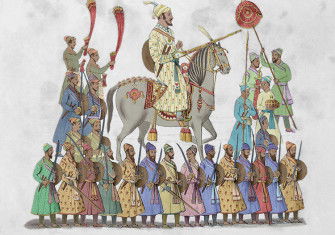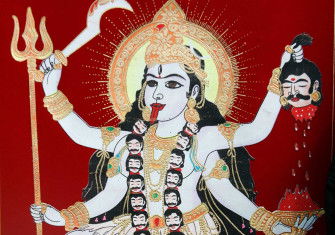‘Guru to the World’ by Ruth Harris review
Guru to the World: The Life and Legacy of Vivekananda by Ruth Harris uncovers the Hindu guru’s life of epiphanies and contradictions.

Gwyneth Paltrow would have us believe she discovered yoga, but really, it’s been around in the West since the 1890s, popularised by the pudgy monk Vivekananda and his bevy of fawning followers. That said, it isn’t easy to place Vivekananda. The world’s most famous celibate, Mahatma Gandhi, cited his influence, but so did the priapic writer Henry Miller. Today, India’s Hindu nationalist ruler fashions himself as Vivekananda redivivus – Ruth Harris’ title sends up Narendra Modi’s own self-description as guru to the world – whereas his left-liberal critics remember him as a radical. Each of these appropriations is misguided. Vivekananda was the kind of chap that Modi’s cow-protecting acolytes would want to lynch. ‘Give me beef’, he is reported to have said in Chicago at the World’s Parliament of Religions of 1893. No liberal, let alone leftist, he was a Hindu supremacist who wanted to save his faith from the clutches of Christianity.
He was also a man of his time, and Harris does a superb job of returning him to the 19th century. A historian of the Dreyfus affair, she’s on firm ground in the world of fin de-siècle ferment. This was still a time when science and séances, religion and rationality could peacefully coexist.
Born Narendranath Datta in 1863, Vivekananda grew up in a family of unreconstructed Brahmos who moved in Calcutta’s reformist circles, scorning idolatry and untouchability. Still, they gave him a Calvinist education, all damnation and hellfire, that he found inauthentic. Aged 18, a chance encounter with an ascetic, Ramakrishna, changed his life. Ramakrishna’s homespun philosophy, welding the easy enchantment of esotericism with an anti-intellectual habit of mind, spoke to Vivekananda, helping him see through the desultory attractions of capitalist life.
Ramakrishna liked to shock the Hindus with degrading acts unbefitting a Brahmin such as touching excrement with his tongue and urinating from a banyan tree. If this sounds puerile, it was intentionally so. He fetishised the innocence of childhood, living naked and resisting adult sexuality. The point was to lose oneself in worship, to find empowerment in submission.
Vivekananda was struck by Ramakrishna’s devotion to Kali, the exuberant goddess despised by Brahmos, commonly depicted with a lolling tongue and a garland of skulls. On the rebound from the formless, abstract God of Brahmoism, Kali must have made a refreshing change. For the first time, he felt he could take pride in the Indian philosophical tradition. Ramakrishna preached the gospel of Vedanta, stressing the underlying unity of all being. Man and God are one. Dualisms – mind and body; good and evil; man and woman – are illusory. There were days when he woke up as a pious Muslim, or a mad child. There were times when he apparently bled like a woman on her period.
If Ramakrishna was an idiot savant, Vivekananda was a marketing genius. He wowed and wooed his way into American high society, sensibly tailoring his message. Kali was quickly forgotten, the male mystics replaced with middle-class matrons. Where the master detested social organisation, the disciple set up communes in which women worked with dumbbells, doing calisthenics and yoga. Likewise, he dispensed with gender fluidity and dressed up Vedanta as a rational religion. The sleight of hand allowed him to use Darwin as a stick to beat biblical creationism, proving the superiority of Hinduism.
Harris is particularly strong on the American religious scene. This was the quaint world of hydrotherapy and homeopathy, vegetarianism and mesmerism, Christian Science and New Thought that feted Vivekananda. He was, in a sense, preaching to the converted. Intellectually promiscuous housewives, though not so much their working husbands, were already experimenting with the many currents of idealism counterpointing Christian and scientific positivism. Vivekananda was quick on the uptake: ‘Your men I do not like. They think of nothing but dollars. But your women – Lord bless them!’
To begin with, there was the ecumenicism encouraged by Swedenborgianism, whose adherents held that God welcomed into heaven people from all religions who did good by their faiths. Similarly, theosophy laid the groundwork for him by esteeming Hindu philosophy in American eyes. Thanks to transcendentalists like Ralph Waldo Emerson, many Americans already believed in the transmigration of souls. Karma was a catchphrase in these circles. All Vivekananda had to do was assert that reincarnation was kinder than the eternal hell of Christianity. A second life as a lower-caste Hindu was a second chance at redemption. More importantly, his anti-intellectualism resonated with Americans. Practical experience trumped philological exegesis: ‘You will understand the Bhagavad Gita better with your biceps.’
America’s women swooned. Purses opened. Bankrolled like a pandemic-era tech start-up, Vivekananda set up the West’s first yoga retreat in Maine in 1894 as well as the West’s first Hindu temple in San Francisco.
His success owed a great deal to his magnetic personality. A gluttonous priest with a raffish charm and a fondness for champagne, he was nothing like the stereotypical sadhu, desiccated and dour. Women were taken by his disinhibition, all the discoursing about genitals over dinner.
Sex talk apart, Vivekananda could be quite reactionary. Viewing the oubliettes of Mont-Saint-Michel in Normandy, where miscreants were stored away and forgotten, he observed that this was a great place for meditation. Harris puts an anti-colonial spin on this, reading renunciation as nationalism. But his purblind positivity seems to me to have had a different objective. Vedanta was a cult of submission. Disinterestedness was a way of accepting one’s station. Vivekananda said as much:
Our educated babus [Anglophone natives] want the British to hand over the government to them! It makes me laugh.
They would be better served, he argued, by ‘asking nothing’ and taking up yoga.
What’s more, Vivekananda defended the caste system even as he opposed untouchability. The gist of his argument was: competition is ugly, so why demand social mobility when you can have job security? His spiritual answers sidestepped social questions. Monism was but a byword for conformism. Not for nothing did he reintroduce Kali worship when he returned to India. Uncritical adoration took the edge off class hatred. A social conservative, he also supported sati, the self-immolation of widows – a spiritual ‘choice’ to him, though in practice rarely ever voluntary. Widow remarriage was ‘the greatest degradation’, a craven capitulation to lust.
Vivekananda’s life was an embarrassment of epiphanies and contradictions, and Harris exhaustively uncovers all of them. I wonder, though, if her analysis at times overreaches. She relates how he once bummed a pipe off a lowly subaltern, pluckily breaking caste boundaries. But we know that Vivekananda was a chain-smoker. Perhaps he just wanted a smoke. I’m reminded of a quip of Sigmund Freud’s: sometimes a cigar is just a cigar.
Guru to the World: The Life and Legacy of Vivekananda
Ruth Harris
Harvard University Press 560pp £34.95
Buy from bookshop.org (affiliate link)
Pratinav Anil’s Another India: The Making of the World’s Largest Muslim Minority, 1947–77 is forthcoming from Hurst.






